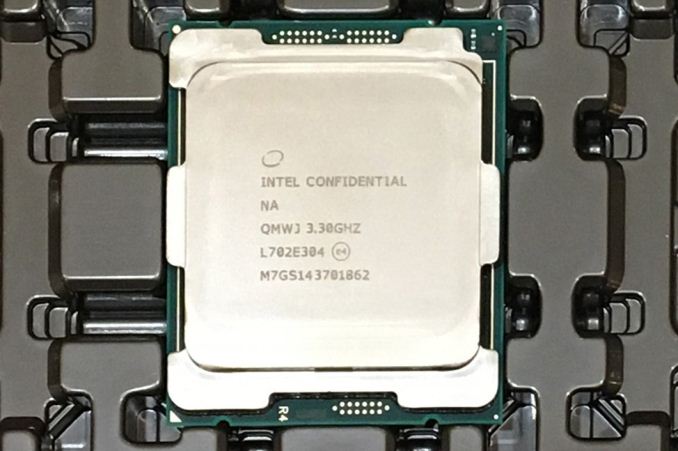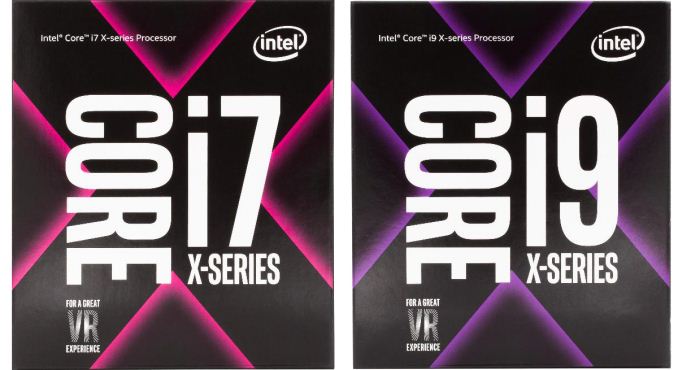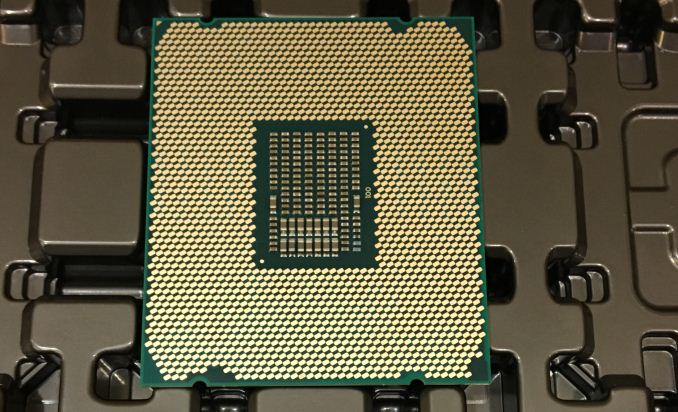The Intel Skylake-X Review: Core i9 7900X, i7 7820X and i7 7800X Tested
by Ian Cutress on June 19, 2017 9:01 AM EST
Building a PC is an experience worth having. Finding out what works with what and putting it all together is an experience, and the first time always gives a sense of achievement and accomplishment. In the high-end desktop space, even more so: trying not to break your first $500+ CPU can be akin to feeling like a surgeon. Following the HEDT space can be a journey, especially after five years of iterative updates we are seeing something special happening in 2017. Intel, the incumbent, is changing its 2017 strategy in a few ways which means there is more to understand, and in the future, and also means it is set to release 18-core consumer processors. Today is the first part of that release, with the new Skylake-X processors: the Core i9-7900X, the Core i7-7820X and the Core i7-7800X. These throw a few curveballs into the mix which are worth walking into.
Back at Computex, Intel announced its new high-end desktop (HEDT) platform code named Basin Falls. There are three elements to Basin Falls: the new X299, chipset which brings a number of enhancements from the more mainstream consumer line, a set of Skylake-X processors based on the Skylake-SP microarchitecture (and slightly different from the mainstream Skylake-S processors launched in 2015) from 6 cores to 18 cores, and a pair of Kaby Lake-X processors, reusing the Kaby Lake-S silicon launched earlier this year but with a bit more frequency and power consumption.
We covered all three parts in our launch pieces (linked below), but here is a quick recap.
Intel Announces Basin Falls: The New High-End Desktop Platform and X299 Chipset
Intel Announces Skylake-X: Bringing 18-Core HCC Silicon to Consumers for $1999
Intel Announces Kaby Lake-X Processors: High-End Desktop Getting the Latest Microarchitecture
Skylake-X Today: Three CPUs, Up to 10 Cores, Lower Pricing than Broadwell-E
One of the big criticisms from the launch of Broadwell-E, the platform before Skylake-X, was that Intel significantly increased prices over the preceding generation. Nominally consumers were used to the fact that the top chip in the stack was $999 to $1099, and rather than readjust the 6, 8 and 10 core parts to do so, Broadwell-E pushed the 10-core Core i7-6950X to ~$1721, in order to claim parity with the enterprise processors. Users who scoffed at that price will be pleased to hear that the Skylake-X processors launching today are priced more in line with Intel's traditional HEDT chips.
| Skylake-X Processors (Low Core Count Chips) | |||
| Core i7-7800X | Core i7-7820X | Core i9-7900X | |
| Cores / Threads | 6/12 | 8/16 | 10/20 |
| Base Clock | 3.5 GHz | 3.6 GHz | 3.3 GHz |
| Turbo Clock | 4.0 GHz | 4.3 GHz | 4.3 GHz |
| TurboMax Clock | N/A | 4.5 GHz | 4.5 GHz |
| L3 | 8.25 MB | 11 MB | 13.75 MB |
| PCIe Lanes | 28 | 44 | |
| Memory Channels | 4 | ||
| Memory Freq | DDR4-2400 | DDR4-2666 | |
| TDP | 140W | ||
| Price | $389 | $599 | $999 |
The Core i9-7900X is the 10-core processor and set to have a tray price of $999, which means the shelf price will be around $1049-$1099. The Core i9-7900X is also the only one with a full complement of 44 PCIe lanes from the processor, as Intel is restricting this feature to the higher cost parts of the stack in order to further differentiate it from the cheaper i7-7800 series. This processor is quite aggressive in its specifications – normally the top LCC processor is clocked down, using the extra cores as the main reason for purchase, but here Intel is supporting a maximum turbo frequency of 4.3 GHz, or up to 4.5 GHz with the new-ish favored core mode. The base frequency is lower than the other CPUs to compensate, at 3.3 GHz, but we saw an all-core frequency at 4.0 GHz in our testing. This all comes in a 140W TDP, with support up to DDR4-2666 in quad channel mode at 1 DIMM per channel (DDR4-2400 at 2DPC).
The Core i7-7820X sits below, exchanging two of the CPU cores and some PCIe lanes for a higher base frequency. This is an eight-core part, which reduces the total cache as well, but has a base frequency of 3.6 GHz to compensate. The PCIe lanes are reduced from 44 to 28 as part of Intel’s product segmentation strategy, although Intel notes this is still enough for a single GPU and three PCIe 3.0 x4 devices (such as storage) directly attached to the processor. DRAM support is the same as the Core i9 at DDR4-2666, as is also the TDP at 140W. Coming in at $599 represents a bit of a step from the 10-core down to the 8-core. This price will arguably draw a good number of users who would rather direct that $400 to something else in their system with the only deficit being two cores and a proper x16/x16 layout for dual video cards.
The bottom processor is the Core i7-7800X, with six cores, a lower frequency (3.5 GHz base, 4.0 GHz turbo, no favored core support), 28 PCIe lanes, and support only up to DDR4-2400. While categorically ‘the runt’ of the litter, Intel has priced this part at $389, only $50 more than the mainstream consumer quad-core overclocking processors. Along with a slight cost increase for the new X299 motherboards, users looking to move from the mainstream to the bottom rung of the high-end desktop can do so with around $120-$150 extra for CPU+motherboard, and then a bit more if the users wants to use quad channel memory (these processors work in dual channel as well). As the low-end part, traditionally users may point to it as a potential overclocking processor – we unfortunately did not have time to test our sample for overclocking, but I wouldn’t be surprised to see it hit the same frequencies as the other two processors fairly easily.
Competition and Market
In previous years, Intel only had one serious angle of competition for the HEDT platform: itself. As it introduced new generation parts, the older generation could (sometimes) be picked up cheaper, making the older generation more enticing. But as it stands, for the first time in a long time, Intel has three main sources of competition for the X299 platform.
First is as mentioned, Intel’s older platform in Broadwell-E (or even Haswell-E). Broadwell-E, aside from the steep pricing, is now a solid platform, with extensive motherboard support and well-known functionality. Intel has not officially dropped the prices of the older processors, which unless the retailers decide to shift stock wholesale might discourage users going for brand new CPUs, but the ecosystem for BDW-E is mature.
| Comparison: Core i9-7900X vs. i7-6950X vs i7-5960X |
|||
| Features | Intel Core i9-7900X | Intel Core i7-6950X | Intel Core i7-5960X |
| Core | Skylake-SP | Broadwell | Haswell |
| Cores/Threads | 10 / 20 | 10 / 20 | 8 / 16 |
| Base/Turbo | 3.3 / 4.3 GHz | 3.0 / 3.5 GHz | 3.0 / 3.6 GHz |
| PCIe 3.0 Lanes | 44 | 40 | 40 |
| L2 Cache/core | 1 MB | 256 KB | 256 KB |
| L3 Cache | 13.75 MB | 25 MB | 20 MB |
| TDP | 140 W | 140 W | 140 W |
| Price (MSRP) | $999 | $1723 | $999 |
Second is AMD’s recently released Ryzen set of CPUs. As the first new serious entry into the HEDT space for AMD in almost five years, along with a new x86 core, AMD offered similar-ish performance to Broadwell-E in many aspects (within a few percent), but at half the price or better. The Ryzen CPUs still had other limits – dual channel memory, only sixteen PCIe lanes, limited IO from the chipset, and a miasma surrounding the launch with motherboards and memory support; but several months on the ecosystem for Ryzen is fairly solid and still a new and exciting prospect for the HEDT crowd. For $60 less than the price of the Core i7-7800X, a six-core Intel processor, AMD offers the Ryzen 7 1700, which runs in at 8 cores at slightly lower frequency, with cheaper motherboards as well.
| Comparison: Core i7-7800X vs. Ryzen 7 1700 | ||
| Intel Core i7-7800X |
Features | AMD Ryzen 7 1700 |
| 6 / 12 | Cores/Threads | 8 / 16 |
| 3.5 / 4.0 GHz | Base/Turbo | 3.0 / 3.7 GHz |
| 28 | PCIe 3.0 Lanes | 16 |
| 8.25 MB | L3 Cache | 16 MB |
| 140 W | TDP | 65 W |
| $389 | Price (MSRP) | $299 |
Both Intel and AMD would argue the merits of the platforms vs. cost, but Intel still this as an angle for competition. Similarly, the 6-core Core i7-7820X at $599 goes up against the 8-core $499 Ryzen 7 1800X.
| Comparison: Core i7-7820X vs. Ryzen 7 1800X | ||
| Intel Core i7-7820X |
Features | AMD Ryzen 7 1800X |
| 8 / 16 | Cores/Threads | 8 / 16 |
| 3.6 / 4.3GHz (4.5 GHz TMax) |
Base/Turbo | 3.6 / 4.0 GHz |
| 28 | PCIe 3.0 Lanes | 16 |
| 11 MB | L3 Cache | 16 MB |
| 140 W | TDP | 95 W |
| $599 | Price (MSRP) | $439 |
Third is AMD’s future HEDT (or Super High-End Desktop, SHED) platform. Announced in the run up to Computex, AMD is set to offer a new X399 chipset with ThreadRipper processors up to 16-core and with 60 PCIe lanes for graphics (plus four for the chipset, which is why AMD keeps saying 64). AMD is using two of its consumer Zeppelin silicon dies on the same package to get up to 16-cores, and has a new socket planned due to the increase in PCIe support. Having had Intel moving from 6 to 8 to 10 cores on the HEDT space over the last 5-6 years meant that AMD announcing a 16-core part was a big enough jolt to this market such that Intel has to provide a response. Pitting a 10-core CPU such as the Core i9-7900X against a 16-core AMD CPU means that AMD would win most the high-throughput heavily-threaded benchmarks, despite perhaps being lower frequency and higher power. For the HEDT/SHED crowd, sometimes it’s all about how quick you can compute. AMD is set to launch the X399 platform and ThreadRipper CPUs in the summer, so we’re still light on details until then, but given AMD's disruptive nature, there's a real risk to Intel that AMD will once again undercut Intel’s equivalent 16-core pricing by a large amount.
| Comparison: Core i9-7900X vs. i7-6950X vs i7-5960X |
|||
| Features | AMD Ryzen 7 1800X | Intel Core i9-7900X | AMD ThreadRipper |
| Core | Zen | Skylake-SP | Zen |
| Cores/Threads | 8 / 16 | 10 / 20 | 16 / 32 |
| Base/Turbo | 3.6 / 4.0 GHz | 3.3 / 4.3 GHz | ? |
| PCIe 3.0 Lanes | 16 | 44 | 60 |
| L2 Cache/core | 512 KB | 1 MB | 512 KB |
| L3 Cache | 16 MB | 13.75 MB | 32 MB |
| TDP | 95W | 140 W | >140W ? |
| Price (MSRP) | $439 | $999 | ?!? |
What Is This Review
This review comes in two big meaty chunks to sink your teeth into. The first part is discussing the new Skylake-X processors, from silicon to design and covering some of the microarchitecture features, such as AVX-512-F support and cache structure. As mentioned, Skylake-X has some significantly different functionality to the Skylake-S core, which has an impact on how software should be written to take advantage of the new features.
The second part is our testing and results. We were lucky enough to source all three Skylake-X processors for this review, and have been running some regression testing of the older processors on our new 2017 testing suite. There have been some hiccups along the way though, and we’ll point them out as we go.
An extra morsel to run after is our IPC testing. We spend some time to run tests on Skylake-S and Skylake-X to see which benchmarks benefit from the new microarchitecture design, and if it really does mean anything to consumers at this stage.
It should be noted that Intel did not provide all the CPUs for this review. As with standard Intel policy, only the top CPU came direct from Intel. All CPUs in this review are classified as engineering samples for partner testing and not for resale, although they are identical to retail CPUs in performance.












264 Comments
View All Comments
Gothmoth - Monday, June 19, 2017 - link
i don´t care about powerdraw that much if i can COOL the CPU and keep the cooling quiet.but in this case the powerdraw is high and the heat is crazy.
and all because of intel insisting to save a few dollar on a 1000 dollar CPU and use TIM?
WTF....
Ej24 - Monday, June 19, 2017 - link
I wish amd would have released Threadripper closer to ryzen. That way amd wouldn't make comparisons of ryzen to Intel x99/x299. They kind of shot themselves in the foot. AM4 is only directly comparable to lga115x as a platform. R3, 5 and 7 are only really intended to compete with i3, 5, and 7 consumer parts. Amd simply doubled the core count per dollar at the consumer line. It's merely coincidental at this point that ryzen core count lines up with Intel HEDT. The platforms are not comparablein use case or intent. All these comparisons will be null when Threadripper/x399 is released as that is AMD's answer to x299.Ej24 - Monday, June 19, 2017 - link
how is the 7740x, 112w tdp only drawing 80w at full load? I understand that tdp isn't power draw but thermal dissipation. However the two values are usually quite close. In my experience, max turbo power consumption surpasses the tdp rating in watts.For example, my 88w tdp 4790k consumes 130w at max 4 core turbo. My 4790S a 65w tdp consumes 80w at max 4 core turbo. My 4790t, 45w tdp, consumes 55w at max 4 core turbo. So how is it the 7740x consumed 80W at max utilization??
AnandTechReader2017 - Tuesday, June 20, 2017 - link
Agreed as on http://www.anandtech.com/show/10337/the-intel-broa... the all-core load for the i7 6950X the all-core load is 135W yet on this graph it's 110W. Something is wrong with those load numbers.Ian Cutress - Tuesday, June 20, 2017 - link
It's consumer silicon running a single notch up the voltage/frequency curve. Probably binned a bit better too. 112W is just a guide to make sure you put a stonking great big cooler on it. But given the efficiency we saw with Kaby Lake-S processors to begin with, it's not that ludicrous.Flying Aardvark - Monday, June 19, 2017 - link
This is an interesting time (finally), again in CPUs. To answer the question you posed, "Ultimately a user can decide the following". I decided to go mini-ITX this time. Chose Ryzen for this, and initially the 1800X. Had to downgrade to the 1700 due to heat/temps, but overall I don't think anything competes against AMD at all in the Node202 today.That's one area where Intel is MIA. Coffeelake will be 6C/12T, 7700K is 4C/8T. R7-1700 is 65W and 8C/16T. Works great. I paired mine with a 1TB 960 Pro and Geforce 1060 Founders Edition.
If I moved to anything else, it would be all the way to 16C/32T Threadripper. I'm really unimpressed by this new Intel lineup, power consumption and heat are simply out of control. Dead on arrival.
Gothmoth - Monday, June 19, 2017 - link
what mobo and ram did you use? is your ryzen build really stable?i need full load stability 24/7.
Flying Aardvark - Monday, June 19, 2017 - link
What, you don't need just 60% stability? Yes it's stable.I did have one bluescreen and it was the Nvidia driver. I think it's unlikely most people would run into whatever caused it, because I use a triple monitor setup and lots of programs / input switching, and it crashed upon a DisplayPort redetection.
I bought the Geforce 1060 because it was the most efficient and well-built blower fan cooled GPU I could find. But buying again, I'd go for the best Radeon 480/580 that I could find.
I never had a bluescreen for decade running Intel CPUs and AMD GPUs so I dislike changing to AMD CPUs and Nvidia GPUs.. but I think it's safest to run a Radeon. Just less likely to have an issue IMO.
Other than that, no problems at all. Rock solid stable. I used the Biostar board and G.Skill "Ryzen" RAM kit.
Gothmoth - Tuesday, June 20, 2017 - link
it´s something different if as system is stable for 2-3 hours under load or 24/7 under load.. capiche? :-)Gothmoth - Tuesday, June 20, 2017 - link
btw... thanks for your answer.i use a triple monitor setup and use many programs at once... what sense would a 8-10 core make otherwise. :-)